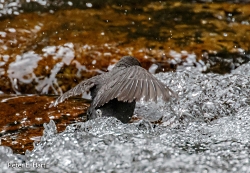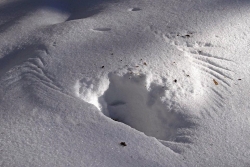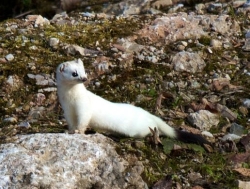
Peter Hart, Photographer
Photo credit: PEHart via Visual hunt / CC BY-SA
Water reptiles and amphibians were in deep sleep in their mud cocoons. They manage winter through slowing metabolic processes which greatly reduces their need for oxygen, nutrition and waste elimination. What little oxygen needed can be absorbed through their skin without breathing.
Animals such as bears can go into an alternate, light hibernation state called a torpor. Torpor is like hibernation, but in this condition, the bear can be awakened easily. I was reminded of this fact from a friend tagging bear cubs in Book Cliffs of eastern Utah. She would enter the bear din very gingerly trying not to awaken a grumpy mom! Ground squirrels are also among animals who torpor, however they shift between hibernation, torpor, and being awake.
The common poorwill, an uncommon bird in Utah Mountains, is the only bird that goes into true hibernation. It hibernates during extreme temperatures — when it is either too hot or too cold — and at times of food scarcity. The common poorwill can even hibernate while they are incubating eggs, proving to be not only a true survivor, but also a riveting multitasking animal.

Courtesy US FWS & Wikimedia, Tamarac Refuge, MN

Photographer: Steven Hint
Courtesy Wikimedia
Licensed under Cc-by-sa-3.0
Living under the snow is not without risk. Owls can hear mice and voles running around underground from thirty yards away. With balled-up feet, they crash through the top crust and all the layers of snow to grab their prey. Foxes and coyotes detect by scent. With an acrobatic pounce, these predators will dive right in for their meal. Suffocation is a hazard for those left behind in a collapsed tunnel.
So what happens to these little critters in a low snow-no snow winter becoming more common in a changing climate? I’m guessing a much higher rate of mortality which may not bode well for those bigger critters- hawks, owls, fox, coyote, etc., who munch them.
This is Jack Greene and I’m Wild about Utah!!
Credits:
Images: Peter Hart, Photographer, Photo credit: PEHart via Visual hunt / CC BY-SA
Courtesy Wikimedia Steve Hint, Photographer, Licensed under Cc-by-sa-3.0
Courtesy US FWS Digital Library
Text: Jack Greene
Additional Reading:
Larese-Casanova, Mark, The Shape of Wildlife in Winter, Wild About Utah, Jan 26,2012, https://wildaboututah.org/the-shape-of-wildlife-in-winter/
Mackay, Barbara, The Subnivean Zone: Shelter in the Snow, Northern Woodlands, Dec 29, 2014, https://wildaboututah.org/the-shape-of-wildlife-in-winter/
Peering into the secret world of life beneath winter snows, National Science Foundation,
https://www.nsf.gov/discoveries/disc_summ.jsp?cntn_id=136986
Snow Tracks, National Wildlife Refuge System, https://www.fws.gov/refuges/features/SnowTracks.html
Glacier National Park:
Winter Ecology Teacher’s Guide https://www.nps.gov/glac/learn/education/upload/Winter%20Ecology%20Teacher%20Guide%202010.pdf
Subnivean Samba: https://www.nps.gov/glac/learn/education/subnivean-samba.htm
4-6, Unit Five, Activity 1: “Snug in the Snow” https://www.nps.gov/glac/learn/education/4-6-unit-five-activity-1-snug-in-the-snow.htm
Winter Ecology, Preparing for your Trip, 3rd-5th Grade Field Trip, https://www.nps.gov/glac/learn/education/upload/3rd-5th-winter-field-trip_GNP.pdf
Rocky Mountain National Park:
Winter Ecology Teacher Guide, https://www.nps.gov/romo/learn/education/upload/Winter-Ecology-Teacher-Guide-for-web.pdf
Craters of the Moon National Monument & Preserve:
Lesson Plan, Prepare for Cold Air!, https://www.nps.gov/teachers/classrooms/prepare-for-cold-air.htm
Helping you share Utah’s natural world!, Utah Nature Explorers, Utah Master Naturalist Program, https://extension.usu.edu/utahnatureexplorers/index
Porpora, Alex, Butts, Neicca, Larese-Casanova, Mark, An Introduction to Nature Journals, Utah Master Naturalist Program, https://extension.usu.edu/utahnatureexplorers/pdflessonplans/generalnature/naturejournaling/Nature%20Journaling.pdf
